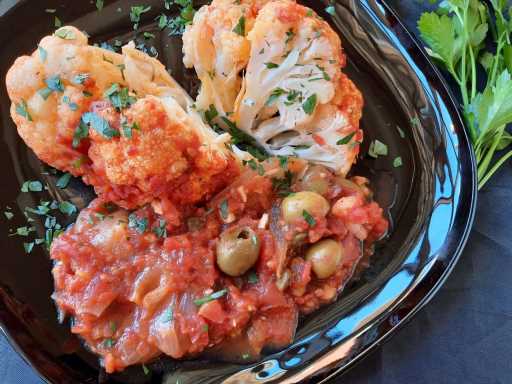Some foods, such as the chicken breast or tofu, are a sort of “canvas” against which a cook can paint other and ancillary flavors, aromas, even textures.
The cauliflower is such a canvas. It has its own charms: its comely appearance, its cooked creaminess, nearly a nut butter when soft. But it also takes on any enticing flavor handed to it. Louis XIV of France enjoyed it braised in chicken or veal stock, flavored with a sprinkle of nutmeg and slathered in sweet butter (to this day, a delicious recipe).
The cauliflower is one of the roughly 400 species of cabbage, Brassica oleracea; along with broccoli (from which it was “trained” or propagated), a flowering cabbage. All cabbages are among the more ancient of vegetables, grown and eaten in especially the regions of Europe and the Near East before recorded history.
New genetically modified versions of cauliflower appear nowadays, such as orange cauliflower (with 25 times the vitamin A of the common white version) and cauliflower’s cousin, the Romanesco, colored the flesh of the avocado or the liqueur Chartreuse and whose futuristic fractals have been studied by architects to find new models for buildings.
The cauliflower is also extraordinarily versatile in the kitchen: It may be eaten raw; lightly cooked; “riced”; cooked through then mashed or puréed; steamed; braised; roasted; sautéed; stir-fried; or simply boiled. And, again, with any of these preparations, most any extra flavoring presents itself.
I have learned a new way of breaking the cauliflower into florets, something I always found annoying because of the cauliflower head’s tendency to “rice” or send its wee white ball bearings all over the cutting board, kitchen counter and floor. After removing what you wish of its core, slice it into slabs about 3/4-inch to 1-inch thick. Lay a slab down flat and cut out or along any branch, breaking away the size of floret you’re after.
To rice cauliflower, simply grate the head against the large holes of a box grater or pulse it up to eight times in the bowl of the food processor. Watch out for the BBs; they’ll be everywhere.
Shop for cauliflower (now available year-long) by picking up a head; it should feel heavy for its size. The florets ought to be tightly packed together, with no large grey or brown spots to mar them and the leaves firmly clinging. Store in the refrigerator by removing its plastic wrapping, wiping it down and re-wrapping it in paper toweling and another plastic bag.
Cauliflower is rich in vitamins C, B and K and several mineral salts. Its levels of vitamin C are higher than orange juice.
Whole Cauliflower Pot Roast
Adapted from cooking.nytimes.com, Jamie Oliver’s “Jamie Cooks Italy” and Cook’s Illustrated “Vegetables Illustrated.” Serves 4-6.
Ingredients
- 1 whole head cauliflower, outer leaves removed and stem cut off at the base
- 1 28-ounce can tomatoes (whole peeled or large diced)
- 1 14-ounce can tomatoes (whole peeled or large diced)
- 3 tablespoons olive oil
- 2 medium onions, peeled, quartered and each quarter broken up into its “petals”
- 6 oil-cured anchovies (or 2 teaspoons anchovy paste)
- 6 cloves garlic, peeled, smashed and rough-chopped
- 1/3 cup dried golden or green raisins
- 1/4 teaspoon red pepper flakes (or more, to taste)
- 1/2 teaspoon herbes de Provence, crumbled in palm of the hand (or more, to taste)
- 1/2 cup green or kalamata olives, pitted
- 3 tablespoons salted, dried capers, rinsed well and squeezed
- Chopped fresh flat-leaf parsley, for garnish
Directions
As if coring the top of a tomato or apple, remove a cone-shaped section from the bottom of the core of the cauliflower. Set the head aside.
To a food processor, add the tomatoes and pulse 7-8 times (only), until rough-chopped. Pour into a bowl or container so the processor bowl does not leak.
Heat the oven, with a rack in the lower middle, to 450 degrees. In a large, heavy-bottomed pot, Dutch oven or cocotte that will fit the whole head of cauliflower standing up on its base and covered, warm the olive oil over medium-high heat and toss in the petals of onion, letting them begin to wilt and turn translucent (6-8 minutes, stirring occasionally).
Remove the onions to a side bowl with a slotted spoon or spider. In the oil in the pot, cook the garlic and the anchovies (or anchovy paste), breaking them up, for 30-45 seconds, just until aromatic. Toss in the raisins, red pepper flakes, herbes de Provence, olives and capers and cook and mix everything well, 2 minutes.
Reintroduce the onions to the pot, then the pulsed tomatoes, stir well and bring to a simmer. Nestle the head of cauliflower down into the sauce, stem side up, spooning some of the sauce over the cauliflower. Cover the pot and place in the oven for 30 minutes.
Remove the pot and, using large tongs, gently turn over the head of cauliflower in the sauce, now putting it stem side down. Spoon some more sauce over the cauliflower, and put the pot back in the oven, now uncovered, for 10-15 minutes more, until the blade of a thin knife easily enters and exits the head of cauliflower at its center.
Remove and let the pot sit to rest, uncovered, for 12 minutes. Cut the cauliflower into wedges and serve with generous spoonfuls of the sauce and other vegetables, garnished with the chopped parsley.
Subscribe to our weekly newsletter, In The Know, to get entertainment news sent straight to your inbox.
Source: Read Full Article

